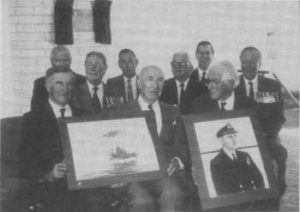- Author
- Zammitt, Alan
- Subjects
- Biographies and personal histories, History - WW2
- Tags
-
- RAN Ships
- None noted.
- Publication
- December 1989 edition of the Naval Historical Review (all rights reserved)
On September 29, 1989, Major General Peter Day, A.O., Commandant at the Australian Defence Force Academy (ADFA) at Canberra invited Mrs J. R. Farncomb, OBE, to officially open Farncomb House and unveil a plaque in honour of her husband, Rear Admiral H. B. Farncomb, CB, DSO, MVO, US Legion of Merit and Navy Cross as well as three times being Mentioned in Despatches during the 1939-45 war.
Thus was added one more honour to one of the RAN’s greatest wartime Captains. His officers called him ‘Uncle Hal’ and the sailors nicknamed him ‘Fearless Frank’. Among those at the Dedication Service were: the Farncomb family together with 3 former Chiefs of Naval Staff with two Rear Admirals, two Commodores, Captains, Commanders and old shipmates from HMA Ships Australia, Canberra, Hobart, Perth, Shropshire, Sydney and Arunta, staff and officer cadets from the Australian Defence Force Academy.

Victor Smith, A.C., K.B.E., C.B., D.S.C., Rear Admiral W. J. Dovers, C.B.E., D.S.C., Commodore Peter Dechiaineux, A.M., Vice Admiral Richard Peek, K.B.E., C.B., D.S.C., Commodore Ian Burnside, O.B.E.
(Photo taken on 29/9/1989 at the A.D.F.A. by Alan Zammit)
Mrs Jean Ross Farncomb, O.B.E., presented a portrait of her late husband with signatures of all at the Service who served under Rear Admiral Farncomb.
Vice Admiral Sir Richard Peek, KBE, CB, DSC, donated a Phil Belbin print of the Battle of the Coral Sea and gave a graphic account of the Battle in which he took part as the Gunnery Officer of HMAS Hobart while Captain Farncomb was half a mile away avoiding torpedoes and bombs in HMAS Australia. Sir Richard said the thirteen-year-old boys who joined the Naval College, first at Geelong and then at Jervis Bay, to be trained as Australia’s first cadet midshipmen, were an exceptional group.
‘To me, three stand out. In alphabetical order they were Collins, Farncomb and Showers and I had the honour to serve under all three.
It was with Admiral Farncomb that I served most – on three occasions, all of them in HMAS Australia. His association with this fine ship was so long and so close that he could even be called Farncomb of the Australia.
He spent almost the whole of World War II at sea in command, an enormous physical and mental burden. He was not only a very great naval officer, he was an Australian of all whom we can all be proud.’
Admiral Sir Victor Smith, AC, KBE, CB, DSC, the first of only two Australians to be promoted to full four star Admiral, said: Such features as H. B. Farncomb being the first graduate of the RANC to be promoted to Captain, his outstanding war service and other matters are well known. What may be lesser known were his high qualities of leadership including his great ability in decision making. What should never be forgotten was the respect and affection in which ‘Uncle Hal’ Farncomb was held by many in the RAN.
Captain L. M. Hinchliffe, DSC, RAN (Rtd), recalled that in 1935 he was Commander Farncomb’s ‘Doggie’ (Runner or Aide). The officers called the Commander ‘Uncle Hal’ but of course never in his hearing. A famous British Admiral asked Midshipman Hinchliffe what he thought of Malta; Midshipman Hinchliffe replied he had not been ashore because he was not interested in the place. Commander Farncomb later sent for the Midshipman and said ‘Mr ‘Bloody’ Hinchliffe, you are to write the history of Malta.’ When Midshipman Hinchliffe told Commander Farncomb the real reason he had not been ashore was because he was broke, Commander Farncomb lent the Midshipman ten shillings.
Chief Yeoman Harry O’Neil recalled that in 1939 Rear Admiral Farncomb was given the nickname of ‘Fearless Frank’ when he signalled to a convoy Commodore HMAS Perth was escorting, in the event of an attack by a raider the convoy is to scatter. ‘My intention is to engage with the enemy with my main armament and close him until I am in torpedo firing range. If gun fire and torpedoes are not sufficient in disabling the raider, I intend to ram the enemy ship.’
Commander A. S. (Donk) Storey, DSC, recalled: My first meeting with Admiral Farncomb was in 1932 when he was appointed as Commander of Australia. Hal Farncomb’s predecessor in Australia was a typical RN martinet of the ‘fire-eating’ sort – they bred them like that in those days!
Harold was a welcome change. He was assiduous in his duties, but managed to combine this with a real understanding of his men. He was strict, but scrupulously honest and fair with his ‘requestmen and defaulters’. He built into Australia a morale which was unequalled.




